Workation » Best Workation Locations and Why You Should Visit Them » Italy Workation – Working and Vacationing in Italy » What to Eat and Where in Italy
What to Eat and Where in Italy
Italian cuisine is anything but one-dimensional, with Northern, Central, and Southern Italy all offering unique flavor profiles reflecting each region’s specific personality.
In the North, butter, lard, and dairy are used to create hearty and rich dishes. Central Italy is all about tomatoes, olive oil, and herbs, while Southern Italy is centered around seafood and lamb, with a hint of spice from chile peppers.
With such diversity in regional cooking, you can explore the different flavors of Italy and truly get a sense of how different each region is during your Italy Workation package.
If you’re into coffee, you won’t be disappointed because the Italian coffee culture is also alive and well, reflecting each region’s traditions.

Northern Italian Food to Eat During your Workation
Northern Italian cuisine is an essential part of the Italian spirit, with local ingredients informing unique cooking styles that shape the regional identity you can experience during your Workation.
Instead of relying on olive oil and spaghetti, Northern Italian cuisine is focused on butter, lard, and dairy-based dishes, many of which were influenced by the historic fluid borders and occupations by the French and Habsburg empires. Popular dishes from the region often involve boiling, frying, slow braising, or stewing with wine or broth and fresh chopped herbs, using few tomatoes.
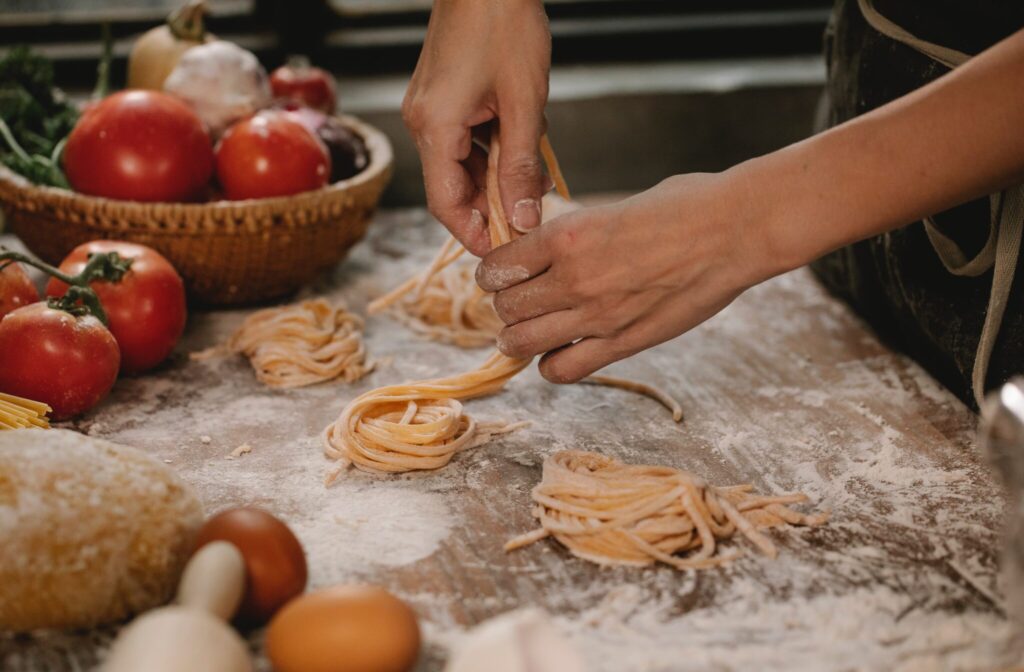
Workations and Bleisure are meant to give you time to build your work-life balance, enjoying the cuisine of your destination as you explore more leisure on your travels. Five popular dishes that truly embody the region’s culinary excellence are Osso Buco, Pesto alla Genovese, Cotechino with Lentils, Salt Cod Crostini, and Risotto alla Milanese. Workaiton can easily help you plan your Workation and Bleisure trip to experience Northern Italian cuisine firsthand as you try the region’s five most popular dishes:
- Trofie al Pesto, a traditional dish from Liguria. This pasta dish is made with trofie pasta, olive oil and basil, giving it a unique and flavorful taste. Legend has it that the women of the region used to sit on chairs along the coast twisting the pasta pieces as they waited for their fishermen husbands to return home.
- Ragù alla Bolognese is another famous dish from Emilia-Romagna. This classic dish is made with a slow cooked meat sauce and is perfect for colder months. The first reference to the Bolognese meat-based recipe served with pasta appears in Pellegrino Artusi cookbook published in 1891, two decades after the unification of Italy.
- Tartufo di Alba is a popular dish in Piedmont and is made with truffles. This dish has a strong and earthy flavor and is a favorite of locals and visitors alike. The Tartufo Bianco d’Alba can only be found in the northern Italian region and has been revered for centuries for its unique and exquisite flavor, especially during Piedmont’s Truffle Festival.
- Bagna Cauda is a dish from Piedmont and is made with garlic and anchovies in olive oil. This is a popular dish for colder days and is a great way to warm up. The dish is believed to have originated from the winemakers in the late Middle Ages.
- Panna Cotta is a dessert originating from the Piedmont region and is made with cream, sugar and gelatin. This dessert is a favorite of both locals and visitors and is a great way to finish off a meal. The name panna cotta was not mentioned in Italian cookbooks before the 1960s but is considered a traditional desert of Piedmont.
Central Italian Food to Eat During your Workation
The cuisine of Central Italy offers some of the most familiar options to visitors shaped by the extensive geography of hills, mountains, seaside, and rivers. Internationally renowned cheese, meats and vegetables are steeped in olive oil, and hardy meat-forward sauces grace the plates. In the summer, the central regions become hotter than the north, providing the recognizable red of tomato-based sauces. The chilly winters provide leafy greens, such as kale. Braised meats and rustic stews are classic holiday dishes. Although the cuisine of Italy is as diverse as the landscape, Central Italian regions share many similarities due to the consistencies in the area’s topography.
The cuisine of Central Italy is incredibly diverse and varied, shaped by its extensive geography of hills, mountains, seaside, and rivers. With the region’s hot summers, tomato-based sauces become a staple and the cold winters produce a bounty of leafy greens, such as kale. Classic dishes of Central Italy often include braised meats and rustic stews, perfect for the chilly winter holidays.
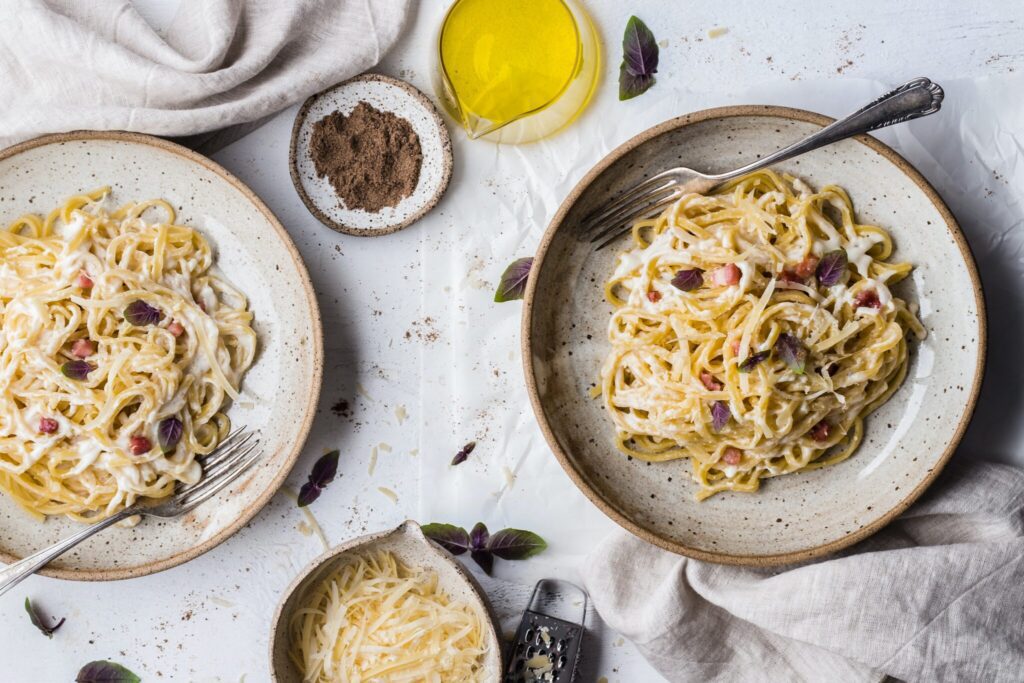
Cheeses and meats are a major part of Central Italian cuisine, with internationally renowned cheeses such as Parmigiano Reggiano, Pecorino Romano, and Gorgonzola, as well as cured meats like Prosciutto di Parma, Mortadella di Bologna, and Culatello di Zibello. Olive oil is an essential ingredient in many Central Italian dishes, adding flavor and richness to the meals.
Five of the most popular dishes from Central Italian cuisine include Osso Buco, Spaghetti alla Carbonara, Salt Cod Crostini, Risotto alla Milanese, and Lasagna Bolognese.
- Bistecca alla fiorntina is a cut of meat made from a part of the loin. The Florentine beefsteak is the undisputed queen of Tuscany’s gastronomy with legend saying it was created during one of the San Lorenzo celebrations. Traditionally the meat comes from a Tuscan breed of cattle called the Chianina.
- Spaghetti alla Carbonara is a creamy pasta dish made with eggs, bacon, Parmigiano Reggiano, and black pepper. One legend says the dish was invented by carbonai or coleman, who would prepare their meal using easy to find ingredients. But another popular idea is that the dish is traditionally from Rome made popular after World War II using available G.I. rations.
- Tagliatelle with truffles comes from Spoleto, an ancient city in Umbria known for its abundance of truffles. While truffles have been a delicacy for millennia, the dish was created in the 16th century by a chef eager to impress the nobility.
- Gnudi with ricotta and spinach is a typical recipe resulting in smooth dumplings often tossed in butter and sage or tomato sauce. They are substantial, composed of flavors that evoke the perfumes of Tuscany, and feature a name meaning “naked” in reference to their absence of starch.
- Arrosticini is a traditional dish from the Abruzzo region of Italy. It is made with cubes of mutton skewered and cooked over a charcoal grill. Legend has it that the dish originated in the Middle Ages when shepherds cooked the cubes of mutton over an open fire. Arrosticini are usually served with a side of vegetables or salad.
Southern Italian Food to Eat During your Workation
Authentic Southern Italian food is often referred to as Cucina Povera, the cooking of the poor cooks who managed to utilize every ingredient at their disposal. Unlike the fertile soils of the north and the affluent industrial or commercial complexes, southern cooks became frugal over the centuries, relying on the bounty of the sea or the hard-fought harvest from tenacious farmers. The warm Mediterranean climate reflects decadent dishes touched with flavors connoting a history of trade and conquest.

The top five popular dishes of Southern Italy are Pizza, Arancini, Mozzarella di Bufala, Sfogliatella Santa Rosa, and Arrosticini.
- Pizza is a classic Italian dish that is especially popular in the regions of Campania and Sicily. It’s made with a base of flat dough, topped with tomato sauce, mozzarella cheese, and other ingredients of choice. The history of pizza dates back to the ancient Greeks and Romans, who ate round discs of fried dough with squashed tomatoes and cheese on top. Pizza evolved into its modern form in the 1700s, when Don Raffaele Esposito, a Neapolitan cook, created a delicacy for King Umberto I and Queen Margherita.
- Arancini is a traditional Sicilian dish made of rice balls stuffed with meat, cheese, and vegetables, then coated in breadcrumbs and fried. This dish is thought to have been created in the 10th century by Arab settlers.
- Mozzarella di Bufala is a type of mozzarella cheese made from the milk of Mediterranean buffalos. This type of cheese is appreciated for its soft texture, delicate taste, and nourishing properties. Sources trace its origins to the 7th century B.C, when farmers used it as a sustaining drink.
- Sfogliatella Santa Rosa is an Italian pastry from Campania, made with a shell of flaky pastry filled with a sweet ricotta cream. It is named after the Monastery of Santa Rosa, located in the province of Caserta. It is said that the pastry was created by the nuns of the monastery in the 17th century.
- Pasta alla Norma is a classic Sicilian dish with an origin dating back to the 19th century Catanian composer, Vincenzo Bellini. A local chef loved one of the musician’s compositions so much, he named the dish after the opera, with traditional ingredients including fried eggplant, tomatoes, garlic, fresh basil, and ricotta salata.
Types of Restaurants in Italy

Dining in Italy is an event but can become confusing when looking at the names of the different types of restaurants but our breakdown can help simplify what each name actually means.
Dining facilities go beyond the familiar names of café, restaurant, or bar to take on different meanings locals understand but can feel like a secret language to visitors.
Where you dine can instantly elevate the beauty and discovery of your Italy Workation or give you a quick meal after returning from a full day out becoming as memorable as the museum you visit or the village you explore, as long as you understand the distinctive meanings, what they serve, and the type of food you want.
Ristorante
The word looks and sounds familiar because it is the Italian word that means restaurant. When dining in a ristorante, you can expect a full service dining experience, most often offering the most high-end service of the different types of eateries in Italy.
Just because the name has the title ristorante does not mean the place will offer the food you want or the type of service for which you are in the mood. You can check the menu, which is most often positioned on the outside or near the entrance for passersby to view before deciding if they want to dine at that particular establishment. It is also a way to check prices before sitting down.
Bar
An Italian bar is a false cognate, creating an association with the English word you know, but meaning something different. An Italian bar is better explained as a corner café where Italians enjoy quick cups of coffee and pastries before, during, or after work. The menu is not extensive but often includes panini, sandwiches, or snacks. The bar is a cornerstone of any Italian neighborhood. In the morning, you can view locals standing around the bar sipping their espresso before starting their day.
Trattoria
The differences between a ristorante and a trattoria are minimal but noticeable. Although they may sound exactly the same, a trattoria is often located on a side-street away from the bustling crowds of the city. The dining room is less formal and smaller than the average ristorante.
A trattoria provides the iconic image of Italy’s family-run establishment with the matriarch or patriarch in the kitchen cooking and serving the nightly specials, which can also be a secret recipe known only to the chef.
Tavola Calda
The Italian term literally translates to “hot table.” These types of establishments don’t generally have chairs, tables, or table service and act instead as Italian fast-food. The food is pre-prepared and on display like a buffet. You choose the item or items you prefer and the staff reheats it.
Tavola caldas are popular with business people too rushed for a long lunch or for those happy to take the delicious food home for a quick dinner without any cleanup. Tavola caldas are also great options if you want fast, hot, economical food to-go for a picnic somewhere in the city, town, or countryside.
Be careful when ordering certain dishes at any Tavola Calda, as certain items are priced by weight as opposed to by piece. In very touristy areas, this can lead to a more expensive meal than expected.
Taverna
The small eatery focuses more on items behind the bar, such as cocktails, wine, and beer, but also provides easy snacks or quick bites to nibble on throughout the day. The taverna is similar to a bar where Italians would populate after work or for a glass of wine at lunch, as opposed to a meal. The menus are not extensive but the items are also more reasonable.
Pizzeria
This is the most familiar type of eatery for people traveling Italy. The iconic cuisine has permeated the entire country, found in large cities and secluded villages. The formality of pizzerias can range across Italy depending on the city and the type of establishment you like with many pizzerias serving whole pizzas as opposed to slices.
Pizza is considered a dinner item and is therefore not ordered or consumed by the average Italian during lunch or breakfast because the item is considered a social food. The dish is served with a crust reaching 12 inches in diameter, light enough for patrons to eat the entire pizza without feeling weighed down.
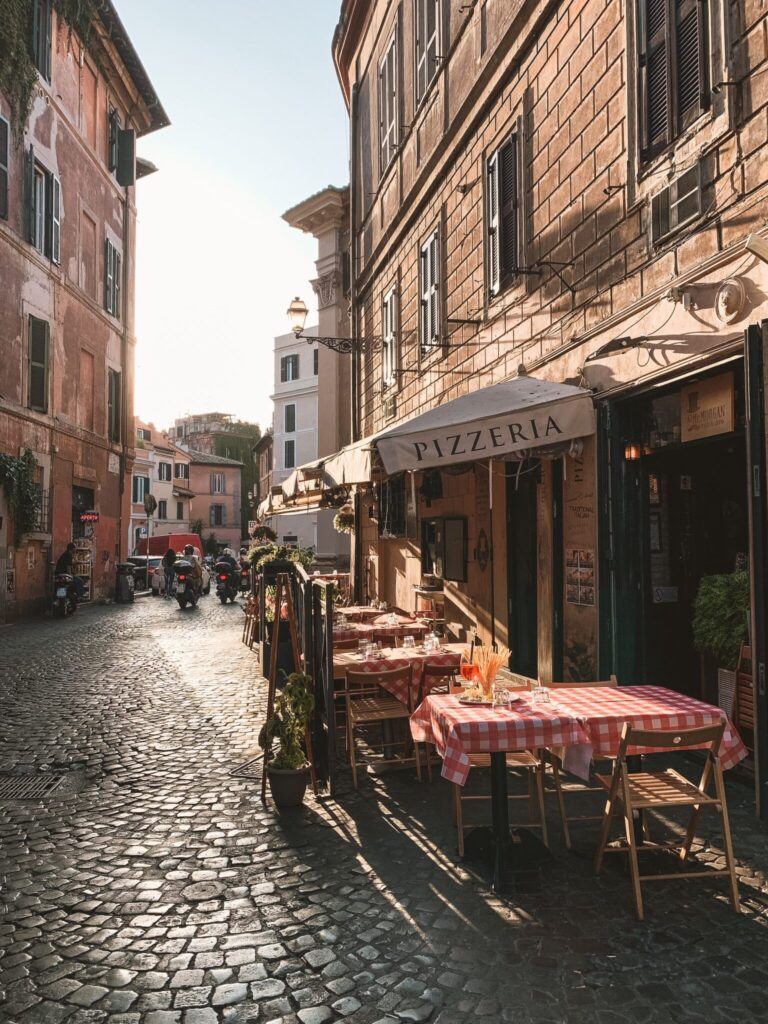
Rosticceria
The idea of a rosticceria revolves around the roasting of chicken or different types of meat. The main items on the menu are made clear by the revolving meats rotating in the window.
The eatery has great selections on other premade meals as well, making them popular with Italians as quick stops en route home from work to buy a delicious dinner for themselves or the family. A rosticceria often offers smaller portions for lunch and has a small selection of tables and chairs at which you can sit.
An eatery specializing in a particular type of cuisine will have the suffix eria; this references the type of food you can expect to find. Beyond pizzeria, you can also find gelateria, which specializes in gelato, like an ice cream shop back home. A restaurant called a “spaghetteria” would focus on cooking great spaghetti pasta while bruschetteria would give you only bruschetta.
There are always exceptions to any rule, but the above are fantastic guidelines for finding the type of eatery you want at any time of day, and in any area of Italy during your Workation.
When in a more popular part of a city, such as on Florence’s Via dei Calzaiuoli, you can expect the food to be more expensive and not the best quality. With a bit of due diligence, it is easy to find one of the many quality types of restaurants around any town morning, noon, or night.
Osteria
If you want ristorante quality without the price and formality, then you can search for a local osteria. The eatery is a neighborhood dining room as opposed to an establishment people will travel to visit, including tourists. The dining room looks similar to a bar but offers ristorante-style service for a casual meal like a local Italian.
Food and Drink
Food and drink can accentuate the beauty of the landscape or completely tarnish what would otherwise be a perfect memory of an unforgettable Italy Workation.
Italy is renowned for its food around the globe, blending Old World traditions with contemporary gastronomical advances. A dish is much more than sustenance for the body but is a representation of Italian heritage, celebrating family, friends, and culture through the continuation of family recipes passed down from generation to generation or created with the intent of showcasing the distinctive flavors of the region.
Dining in Italy feeds the soul as much as the stomach and is meant to experience. The typical restaurant serves dishes differently than Italian restaurants you might think of back home. The server offers sparkling or still water at an additional cost to the meal. Tap water is fine to drink but drinking bottled water has become a tradition throughout Italy. Traditional restaurants serve dishes a la carte and generally separate their menu by antipasti, primi, secondi, contorni, and dolci.
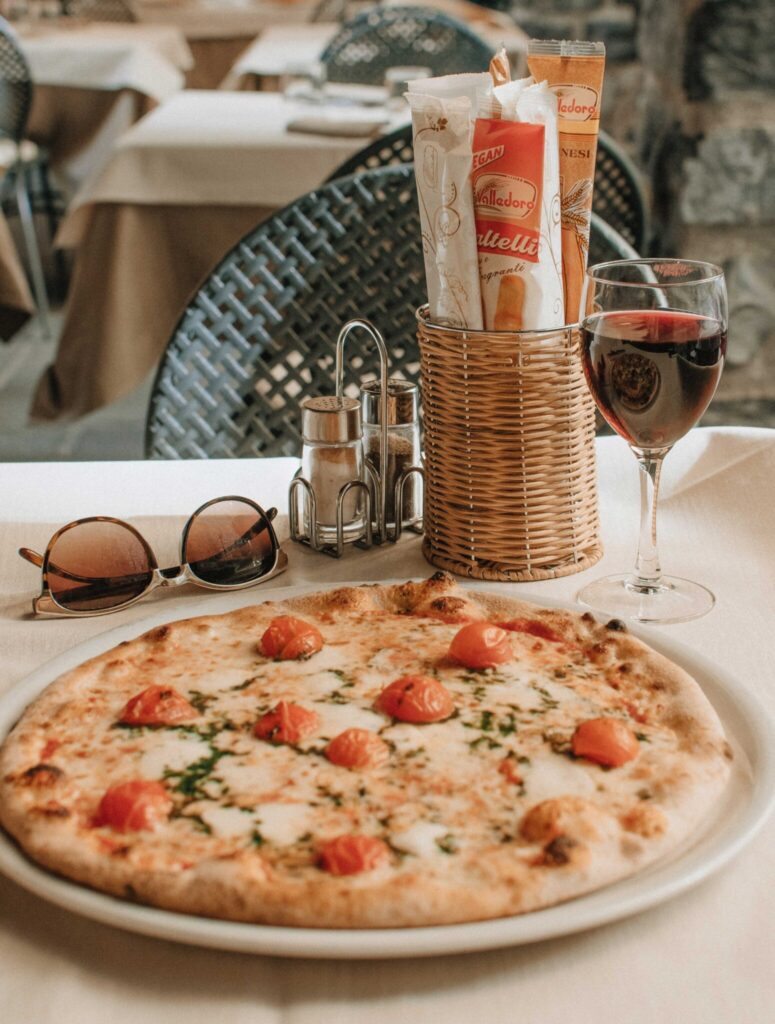

Antipasti
These smaller dishes are served before a pasta dish. In English, we refer to the dishes as appetizers. They can be cold or hot dishes from land or sea. The most common type of antipasto is salad.
The purpose of an antipasto is to tell the diner that something delicious is coming, adding a mouthwatering embellishment to the beginning of the meal. The term is often confused with meaning a dish served before a pasta course due to the combination of “anti” and “pasto,” however, the true roots stem from Latin, with anti meaning before and pastus meaning meal.
The course refers to a dish preceding the meal. The artful color and composition of the antipasto remind diners that a meal is time for pleasure, relaxation, and even indulgence. The pre-course awakens the senses and the palate for the meal to come, combining a contrast of textures, flavors, and colors from a selection of marinated olives to the famous caprese, a salad of buffalo mozzarella, basil, and tomato drizzled with olive oil and balsamic vinegar.
Contorni
The contorni section of the menu is related to side dishes. The particular feature encompasses dishes such as cooked or raw vegetables or potatoes and a selection of side salads. Restaurants serve contorni traditionally to accompany secondi, which are all served a la carte.
The side dishes are served on separate plates from primi or secondi options to preserve the integrity of the original cuisine’s flavors. Side dishes are ordered separately from other dishes on the menu, which often surprises visitors from western English-speaking countries.
Primi
Primo in Italian means first, therefore, when listed on a menu, the word primi refers to the first courses. These options involve dishes heavier and pact with more depths of flavor than the antipasti. Primi dishes do not consist of meat and instead offer fine and luxurious ingredients for seductive risotto, gnocchi, or pasta.
These dishes often have rustic elements and touches, including a vegetable flan or savory tart. Soup is also listed as a primo dish, but not on all menus. Soup is considered a comfort-food found at home, however, certain types of soups have made their way onto menus at sporadic restaurants across Italy.
The types of soup include fish soup or minestrone, a tomato broth mixed with a hardy portion of vegetables and beans, with some chefs sometimes adding rice or pasta.
Secondi
The word secondi in Italian means second. The second course of an Italian restaurant meal represents different dishes and design than the antipasti and primi courses with a focus on protein options referring to meat and seafood.
The menu reflects the region by featuring the common and customary ingredients of local cuisine, which could include chicken, quail, beef, pork, boar, lamb, turkey, or rabbit prepared as roasted, grilled, or also sausage.
Seafood dishes tend to contain shrimp, lobster, shellfish, or a robust seafood option, such as octopus or squid. The second course is richer and contains a more dominant flavor than antipasti or primi dishes and characterize the main course of the meal.
Dolci
The word dulci represents the desserts and sweets on the menu. The traditional options of Italian dessert change between regions and even between provinces within the same region. The most common type of dessert found on an Italian restaurant menu is gelato.
Other desserts might include tiramisu, panna cotta, cannoli, or rum baba but these options wholly depend on the region in which the restaurant is located and season during which the menu was devised.
Certain restaurants offer sorbetto options as palate cleansers at the end of the meal.

Italians often skip the dessert altogether and enjoy a coffee or a digestivo after dinner. Traditionally after the meal, Italians will sip a strong, warm espresso served without milk or sugar.
The more decadent the meal, the more common someone orders a digestivo. The alcoholic beverage, such as the citrus-forward limoncello in the south, herbal liqueur of amaro in Central Italy, and brandy-style grappa in the north, help aid in digestion and settle the stomach.
The Slow Food Movement as a Workation Experience
The Slow Food Movement encourages us to take time to enjoy the simple pleasures of an unhurried life. This helps us reduce the pace of our lives and become more mindful of our eating habits, which includes the flavors we appreciate and why.
By slowing down the process and understanding what we eat, as well as why, the Slow Food Movement also encourages supporting local community farmers, fishers, food producers, and more in order to preserve cultural recipes, ingredients, plants and seeds, domestic animals, and farming within an ecoregion.
To gourmets, foodies, and involved chefs, the Slow Food Movement is not a movement at all and is instead, a revolution. Started by the Italian professional gourmet, Carlo Petrini, in the 1980s, the chef brought the movement into existence to push against the trend of mass-produced meals known for their tastelessness and empty calories. The movement has amassed more than tens of thousands of members since its founding as an informal talking point for young foodies in Bra, Piedmont where locals once assembled in small trattorias sipping regional wines and enjoying the cuisine of their home.
The movement continues to promote an alternative to fast food with the goal of providing sustainable foods while promoting small businesses paralleling the push against the globalization of agricultural products. Over 150 countries have members who participate in the movement, with the most chapters and members residing in Italy.
The educational institution University of Gastronomic Sciences opened in 2004 in Pollenzo, Piedmont and teaches the awareness of good food, nutrition, and the cultural heritage of cuisine based upon region. The program has developed an international catalog of endangered heritage foods to sustain the unique tastes of each distinct ecoregion, along with providing grassroots organization to promote the slow food movement and its importance in public discourse.
Petrini stresses the importance of lobbying against pesticides and teaching gardening skills to students, but also prefers to celebrate the beauty of local cuisine with regional tastings and festivities promoting different cooking methods or ingredients.
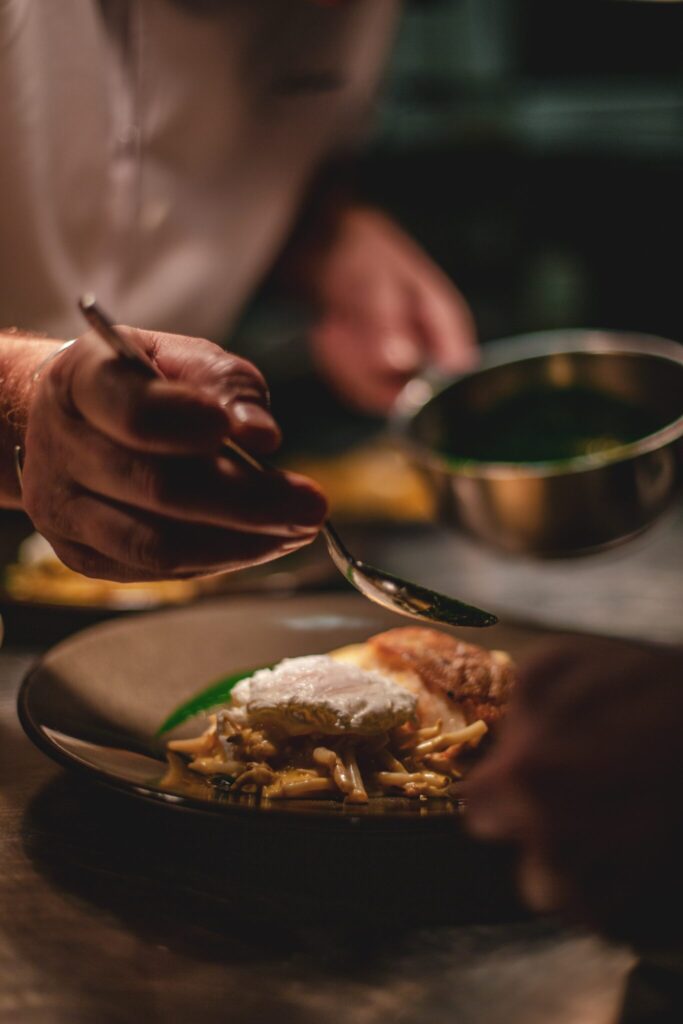
One of the major tenants of the Slow Food Movement in Italy and worldwide is the Ark of Taste: The project identifies and catalogs ingredients, dishes, and plants in danger of disappearing from the world stage due to pesticides, over-farming, overpopulation, over-hunting, or the lack of interest in passing down cultural heritage to the next generation. This massive project is meant to help preserve traditions and carry on cultural heritage for generations to come.
During your Italy Workation, you can take part in regional culinary traditions, sample the protected flavors of historic towns, or discover new dishes taught by a local grandma whose recipe you can take home with you.
Find Where to Visit and What to Eat on Your Workation

For your Italy Workation, the right region to visit could make all the difference between enjoying your stay and finding your best work-life balance. Famous works of art and unforgettable ancient monuments meet incredible landscapes and traditional villages with histories spanning two thousand years. Look for the magnificent blue water, stroll through preserved medieval streets, and learn about the specific flavors helping create the unique vision of factors that make Italy.
Find the information you need to give you the best Italy Workation possible before allowing us to accelerate your productivity and maximize your experience with an authentic connection to Italy. Take one step closer to planning your Workation or learn more about What Festivals People Celebrate in Italy.
More articles on Italian food and drinks
- Foods Enjoyed by Locals in Northern Italy
- Discovering the Hidden Gems of Italian Cuisine During Your Workation
- Foods Enjoyed by Locals in Tuscany
- Foods Enjoyed by Locals in Rome
- Italian Coffee Culture Guide
- Popular Food Festivals in Italy
- Popular Italian Wines to Enjoy During Workation
- Foods Enjoyed by Locals in Venice

